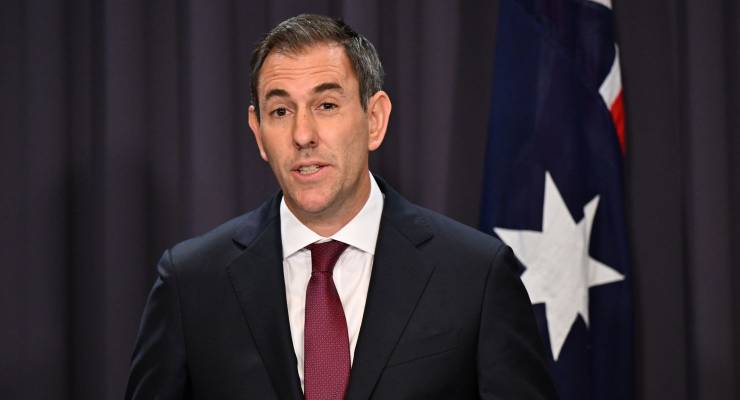
In today’s Mid-Year Economic and Fiscal Outlook (MYEFO) report, Treasurer Jim Chalmers and Finance Minister Katy Gallagher say this year’s budget deficit will shrink to virtually nothing off the back of another surge in tax revenue and slightly higher than expected growth. But inflation is expected to be higher, and households will retreat even further into their shells despite a strong labour market.
The deficit for 2023-24 will be a nominal $1.1 billion, compared with an estimate of $14 billion last May, and the projected deficit for 2024-25 will come in at around half the previously forecast $35 billion before the deficit blows back out.
GDP is expected to grow slightly faster than previously forecast in 2023-24, but still at a very tepid 1.75%. Unemployment is still forecast to rise to 4.25%, but participation is expected to be (even) higher — at 66.75%; still a record high that demonstrates the persistent strength of the labour market (and how many households need two incomes).
Wages growth is still expected to max out at 4% before falling in 2024-25, but inflation is expected to be a full half a percent higher in 2023-24 at 3.75%, before falling back into the Reserve Bank target band the following year.
Despite the strong labour market, Treasury expects households to pull their heads in even further — household consumption, previously expected to grow at a weak 1.5%, will only grow 0.5%, and only at 2% the following year, suggesting lingering weakness from high interest rates and rundown household savings.
Things are expected to be better on the trade front — an expected big fall in terms of trade won’t be as severe and, combined with higher exports, will see a current account surplus next year.
The tax revenue surge this year is around $16 billion (split evenly between income and company tax), but revenue is also expected to be $19 billion stronger in 2024-25. The government has banked all but $4 billion of this year’s expected increase and $3 billion of next year’s, although the out-year figures suggest quite a bit of spending has been pushed back rather than axed.
Despite the temporary reduction in this year’s deficit from forecast levels, it is government spending that continues to be crucial to an economy being hammered by high interest rates. Public final demand will grow by 2.5% this year, up from the budget forecast of 1.5%, while private demand growth is now expected to be weaker.
Key to that public spending are highly targeted anti-inflation measures: “Electricity rebates, increases in child care subsidies and Commonwealth rent assistance are estimated to have reduced annual inflation in the September quarter 2023 by half a percentage point. The government’s cost-of-living measures are estimated to reduce annual inflation by three-quarters of a percentage point in the June quarter 2024.”
The numbers make it even harder for the government to ditch the stage three tax cuts, if it was ever minded to. Off the back of what may well be two surpluses in a row and a big fall in the expected deficit for the following year, even with the tax cuts kicking in from July 1, 2024, the government will find it hard to argue that there’s a fiscal imperative to dump the cuts.
With inflation expected to fall back between 2% and 3%, the economy struggling to grow faster than 2% and household demand struggling, a substantial injection of cash into the economy for households might be less putting a rocket under inflation and more supporting growth and backing households.
As for the long-term fiscal direction of the government, in May the budget predicted a smaller but still substantial gap between our spending — between 26% and 27% of GDP — and our revenue, around 25% and a bit. MYEFO amends that story somewhat: spending is expected to hover around 26% of GDP while revenue remains about the same as previously forecast. The result is another fall in net debt, which is now expected to peak not much above 20%. In the Morrison years it was expected to reach a third of GDP.
The gap is still there, and politicians are still reluctant to talk about it, but every time it shrinks it pushes the day of reckoning a bit further away — at least for politicians.









Hopefully Chalmers takes a tax cuts package to the next election that strips some of the egregious high income handout and redistributes to low and middle incomes. Plus banking a bit.
Could be a winner if a significant % of voters get a bit more than under Stage 3 and it would address the Liberal’s inequality drive a bit albeit not nearly enough as it should be.
Who does Chalmers think he is kidding? The only reason we have a positive GDP figure is because of the (quite frankly) high and unsustainable levels of net migration. This is the hallmark of the lazy Treasurer. Worked a treat for Keating and some of his inept predecessors Dawkins and the pedestrian Ralph Willis. Worked for Costello too. Ditto Swan and that tennis wannabe Josh Frydenberg, even though he did manage to score a recession. Australia has had more per capita recessions than Mick Jagger has had occasional girlfriends. Chalmers can’t and won’t face the real cause of inflation. He is as powerless against his department and the organs of the RBA and the PC as every US President has been in facing up to J Edgar Hoover. We had had almost b—–all wage rises. Just the way Jim likes it. He’s no friend of the worker.
You seem to have your cynicism dialed up to 11. For a country that hasn’t had a good treasurer since, I suppose Chifley, things aren’t too bad despite the waste of our good fortune. Compare us with Argentina.
Like the desperation of US RW MSM talking down or simply avoiding positive economic news to denigrate Biden and the Dems, ditto locally with PM & ALP, while UK which is in fact a bit of a post Brexit basket case, is being talked up with Tories in power; too easy and predictable with biased Anglo media, why?
However, it seems to work across RW MSM with a mass of retirees who are no longer in the workforce, but have minimum guaranteed income and services to boot, who then follow RW spin?
“Australia is a lucky country run mainly by second rate people who share its luck. It lives on other people’s ideas, and, although its ordinary people are adaptable, most of its leaders (in all fields) so lack curiosity about the events that surround them that they are often taken by surprise.”
Chalmers is a charlatan. It is duopoly power that is generating inflation. Coles and Woollies bump up their prices with no hint of competition. Same for the banks, finance and insurance companies. They all operate as a cartel. And no we haven’t had a really decent Treasurer since Chifley but we had a very capable one in Bill (love child not mentioned in biography) Hayden. Mr Charisma minus. Keating a decent Treasurer. He damn near gave us a GST on top of his rip off Accord wage deals. He simply followed the script of one Keith Campbell, former chairman of Hooker Corporation, who headed an inquiry into banking in Australia in 1979 and reported to the Federal Government in 1981 under the hopelessly inept sheep farmer Malcolm the Terrible Fraser. That is all. He wasn’t a decent treasurer. He simply followed the advice of others who knew better. As for comparing us with Argentina that is exactly where we would be if we hadn’t gone down the path recommended by the Campbell Committee.
Things aren’t too bad but much of the good work was done earlier. I think Chalmers is chicken scared and s—, particularly if a good scare campaign heats up. He’ll jumble his words up like that other former inept Treasury spokesperson for the opposition years ago in Chris Bowen.
Curious that the Crikey team skips over facts widely reported elsewhere – bracket creep income tax rates are back at record highs, giving a perfectly legitimate reason to continue with stage 3 tax cuts
Given the vast amounts of money injected into the economy over the last few years, taking some of it back out with relatively (bearing in mind Australia is one of the lowest taxing countries in the OECD) high tax takes for a while seems reasonable ?